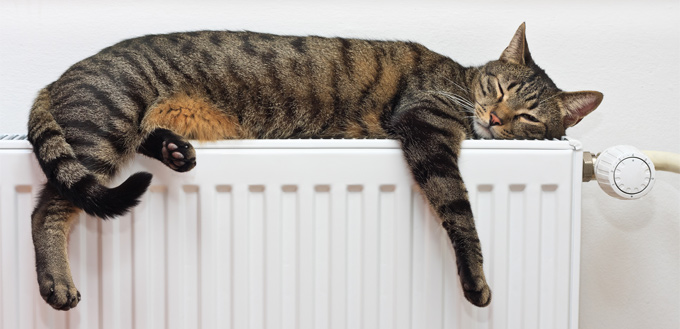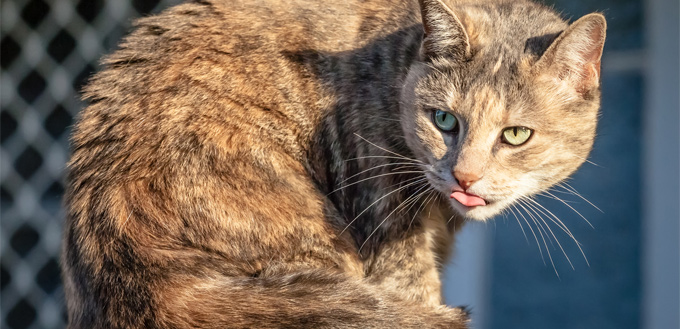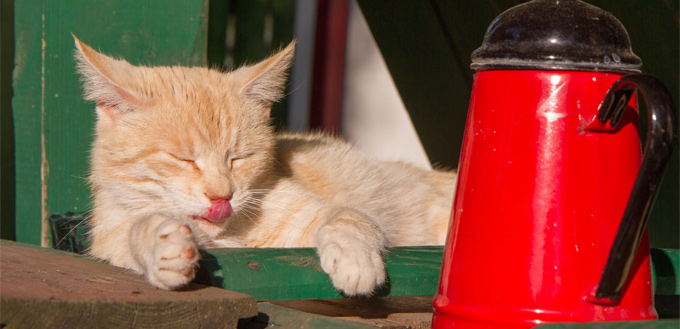It is extremely important to keep a close eye on your pet’s health. Your beloved pet may not be able to complain but it can go through certain health problems that you should be aware of. Heat stroke is one such problem and it is more common in cats than you may want to believe. This condition is also known by many other names such as hyperthermia, heat stress and heat exhaustion.
Your furry friend is at risk of this malign when the surrounding or outside temperature reaches too high and as a result, the poor animal’s bodily functions are not able to regulate it. Generally, a temperature above 104 degrees Fahrenheit or an equivalent of 40 degrees Celsius is assumed to be the limit a cat can endure. If this is surpassed then it will lead to overheating or a heat stroke. But worry not! Because this article will walk you through all you need to know about heat strokes in cats including symptoms, risk factors, reasons, precaution, prevention, and all other essential information.

Why Is It Important?
Heat stroke or hyperthermia in cats can have fatal consequences. Although contrary to the popular belief that cats are a desert animal, they have weak heat-regulating mechanisms, due to which it is not abnormal for them to get a heat stroke. In extreme cases, this can lead to life-threatening consequences. There have been reported cases of heat strokes in cats which lead to malfunction of organs, multiple organ failure, intestinal bleeding, and other perilous health conditions. In severe cases, it has also been a cause of death. Thus it is extremely crucial that you are aware of the symptoms and risk factors so that you can take action as promptly as possible and save yourself and your cat from a life-altering experience. Taking good care of your pet’s health is an essential part of nurturing and loving it; more so when it is completely dependent on you for its food, shelter, and survival.
What Is the Primary Reason for Heat Stroke in Cats?
A heat stroke or heat stress typically occurs in cats when the cat’s elevated core body temperature rises above the normal range. A cat’s normal body temperature is between 100 to 103 degrees Fahrenheit (or 38 and 39 degrees Celsius). If the core body temperature reaches beyond this, it is harmful because your cat will not be able to get rid of the excess heat as fast as it is required at that situation. Cats do not have many sweat glands to get rid of the excess heat; only a few in their paws and around their nose. Furthermore, they have a much thicker coat of fur that lines their entire body. These features elevate the risk of heat stroke in cats, which is why they are more susceptible to damage and are poorer temperature regulators.

What Are the Risk Factors of a Heat Stroke in Cats?
Like all other things, there are certain factors that make cats more susceptible to a heat stress. Some of these can be avoided and some cannot. These risk factors are:
- Adults of greater age: Elderly cats are at higher risk of getting a heat stroke as age makes it tough for them to regulate their body temperature.
- Overweight and obesity: Overweight cats are more open to getting a heat stroke than average ones. Due to their large mass, it takes less effort for the heat to get them.
- Breed of a cat: Certain cat breeds are proven to be more at risk of getting a heat stroke than others. Especially the ones with features such as flat faced and stubby nose, who are also known as “brachycephalic” cats. These cats include the species: Persian, Himalayan, British Shorthair, and Scottish Fold.
- Chronic and acute illnesses: Existing illnesses is also a predisposing factor putting your cat at a higher risk of attaining heat stroke. Health conditions such as respiratory, cardiovascular, neurological or kidney disease pose a higher risk of heat stress.
- Excessive exercise: Despite exercise being good for your cat’s overall health, excessive exercise is not a good idea during hot and humid days. This will make your cat go warm very fast.
- Environmental factors: Some environmental factors such as high temperatures and excess sunlight are also risk factors of attaining heat stress.
- Surrounding conditions: The surrounding factors such as a poorly ventilated place, dry and confined space or an area with a lack of water also pose an increased risk.
- Coat of fur: A coat of fur all over the animal’s body naturally makes its temperature high. Cats with dark colored, long and thick fur are easy targets because of their better-insulated bodies and better heat absorption capabilities.
Related Post: Best Cat Food for Weight Loss
What Are the Symptoms of Heat Stroke in Cats?
Being a pet owner it is necessary for you to have proper knowledge about the possible health problems your cat may face and how to recognize them. The faster an action is taken to prevent it, the better it is for your cat. There are several symptoms with which you can spot a heat stroke beforehand. Listed below are eighteen reasons that will guide you to spot a heat stroke in your cat:
- Panting and wheezing: If you notice your cat is suddenly panting or breathing with its mouth open, this can be a sign of heat stroke. Although in some cases it can be of other health concerns.
- Restlessness and agitation: If your cat is behaving weird, you should find out if it has suffered a heat stroke. Your cat may be walking around unnecessarily or behaving as if it is out of its comfort zone.
- Sweating from the feet: Cats do not have many sweat glands to dissipate its body heat; paws are one of the very few places which allow it to do so. Thus if your cat is sweating from the paws it is a signal that the cat is getting rid of excess heat from its body.
- Drooling and salivation: Your pet cat will exhibit some abnormal behavior one of which is excessive drooling and salivation; this is a sign of heat stress. You can also check if the saliva is sticky to be sure.
- Bright red tongue: If you see that the color of your cat’s tongue has changed from pink to a bright red, it is a matter of concern because heat stress sometimes leads to that.
- Pale or dark red gums: Another oral symptom of heat stroke is pale or dark red gums. Although sometimes it may indicate other things, this is often a sign of heat stress.
- Weakness and fatigue: Most cats are lethargic by nature and like to lie around royally in their kingdom, but if you notice your cat is awake but not alert or moving, it can be due to heat stroke.
- Muscle Tremors: As this is internal it will be difficult to notice, but there will be other factors and signs which will help you know that your cat is experiencing a muscle tremor.
- Trembling and shaking: This is an aftermath of the previous symptom; muscle tremor. Due to the involuntary muscle contraction, there will be unintended trembling and shaking of your cat’s body.
- Increase in heart rate and rapid pulse: This is a related symptom tied with other symptoms. If your cat is feeling uneasy, queasy and wheezing, the heart rate will automatically increase along with rising body temperature.
- Vomiting and nausea: You should watch out for this as this is a symptom when the temperature continues to rise constantly. You should be super concerned if you notice blood with vomit.
- Breathing Problems: If you notice your cat inhaling and exhaling loudly or having trouble to do so, it can be because of facing breathing problems. This is also often a symptom of heat stress or stroke.
- Mental confusion and frenzy: If your cat is behaving awkwardly and looks frenzied, such as glancing oddly or seeming in a confused state, it can be an effect of heat exhaustion.
- Dizziness and uncontrolled movements: As a result of the rapid increase in temperature, your cat is likely to feel dizzy and show signs of uncontrolled movements such as twitching.
- Collapsing or fainting: This is an extreme circumstance and will happen when your cat can no longer withhold agitation. If your pet cat faints, take it to the nearest veterinarian immediately!
- Little to no urine production: Heat stress causes some bodily changes one of which is a change in the production of urine. This is also a sign of fatigue and dehydration.
- Glazing and red eyes: Just like we humans tend to have glazing red eyes when we feel extremely hot, so do cats. Only they cannot communicate with us! So look out for this sign of a heat stress.
- Unnecessary grooming: Often cats start to groom themselves unnecessarily while experiencing a heat stroke. They do this thinking that it will bring down the temperature.

Heat Stroke Prevention for Cats
Despite the fact that there are so many conditions and predisposing factors which pose a greater risk of your cat getting a heat stroke, there is an equal number of prevention factors as well, maybe more! There are many things which you can do to prevent and save your cat from getting a heat stroke, some of which are:
- Keep your cat around or near you at all times, especially during hot days. By monitoring the cat well you can know in what condition your cat is and what it is up to.
- Set a proper living space for your cat. Your cat must have easy access to shade and water. You must ensure proper ventilation at the spot and see that direct sunlight does not fall upon it.
- Introduce some changes to your pet’s eating habits. It is advised to feed your cat canned food if you already do not do so. Adding water or tuna water to regular cat food is also encouraged to increase its fluid intake.
- Keep your cat hydrated at all times, both internally and externally. Your cat should have a bowl of water or a cat water fountain within its vicinity all the time so it can drink from it and also wash when needed.
- Do not leave your cat alone in the laundry room or vehicle alone. Often, cats somehow end up in the drier and this results in fatal consequences. The temperature in a closed car can rise rapidly and if your cat is stuck in there, it will definitely face a heat stroke. An easy solution is to turn the air conditioner on or to keep the windows slightly ajar for air to pass.
- Choose the environment that best suits the need of your cat. If your apartment does not have air conditioning and proper ventilation, then let it get some fresh air from outside. However, if it is a very hot and humid day, keep it hydrated and cool indoors.
- Avoid hot and flat surfaces for play areas. Do not leave your cat unattended or let it play on hot sand or a sandbox on warm summer days. Temperatures in there soar up pretty fast. Also, avoid concrete or asphalt areas where there is no room for heat to escape and rather it is absorbed.
- Do not let your cat do excessive exercise on hot and humid days. Exercising makes the body temperature go up and releases a lot of sweat. This can make your cat more prone towards attaining a heat stress.
- Act sensibly. Know and understand the symptoms of heat stroke and act accordingly. If you detect our cat got a heat stroke, after all, play smart and act quickly. Take the best decision that suits the condition of your pet cat.
- Get a regular checkup and consultation from your veterinarian. Whether or not your cat is suffering from health conditions, it is always a good idea to keep a close eye on its health. This way you can also find out which diet suits your pet best and whether it is overweight or not.
Related Post: Best Cat Water Fountain
Treatment for Heat Stroke in Cats
What if somehow you end up in the unwanted situation of your cat getting a heat stroke? Fortunately, there are many treatment options for a heat stress. Knowing them will help you during times of hopelessness and distress; you will know what to do then. In mild heat stress conditions, there are many things that can be done at home to treat heat stroke, which are:
- Immediately remove your cat from the hot place and put it in a cooler zone. If an air-conditioned room is available, then that is the best possible choice. This will start to stabilize body temperature.
- Apply water on the cat’s fur and skin. This can be done by spraying water or by rubbing a wet cloth over the pet’s skin. Either way, the core temperature will start to come down.
- Be careful not to use ice cold water as it will make the problem worse; tepid water is optimal. A sudden drop in temperature will lead to hypothermia which is why a gradual decrease is a preferable alternative.
- Fan your cat. This way air will reach in between the furs and maximize heat loss. This will show the best results if it is paired with spraying water on your cat.
- Keep an eye on the temperature. Measure the cat’s temperature after five-minute intervals to keep a check and continue cooling if needed. When the temperature reaches 103 degrees Fahrenheit (or 39 degree Celsius), it is back to normal.
However, despite taking these measures, a veterinarian check up is always absolutely mandatory. Starting the treatment earlier at your home substantially reduces risks but your vet is a professional and will definitely know better how to treat your cat. This is also advisable to avoid further complications and be safe. What your vet might do is:
- Run blood tests and urine analysis to ensure it is a heat stroke and not an infection.
- Provide ice packs and closely monitor temperature. This remedy can also be started at home.
- Inject an intravenous (IV) fluid line to your cat’s body so that cool and hydrating fluids run directly into its body. This will also stabilize it and reduce risks of organ damage.
- In more extreme cases, oxygen therapy and admission to the hospital may be required.
This was your complete guide to the know-how of recognizing and properly treating a heat stroke in your cat. Despite proper prevention, if a heat stroke still occurs, there is a chance of recurrence thus keep your vet close by! Good luck to you and your cat/cats and happy petting!
You may also like our article on: Why Do Cats Fall Over
Sources:
- Sarah E Cudney, Clothes Dryer-induced Heat Stroke In Three Cats, National Library of Medicine
- Keep Your Pets Safe During Hot Summer Days, Animal Humane Society
- Christine Rutter, Hot Topic: Keeping Your Pet Safe As Temperatures Rise, Veterinary Medicine & Biomedical Sciences
- How Can I Prevent Heatstroke In My Pet?, American Animal Hospital Association
Note: The advice provided in this post is intended for informational purposes and does not constitute medical advice regarding pets. For an accurate diagnosis of your pet's condition, please make an appointment with your vet.







